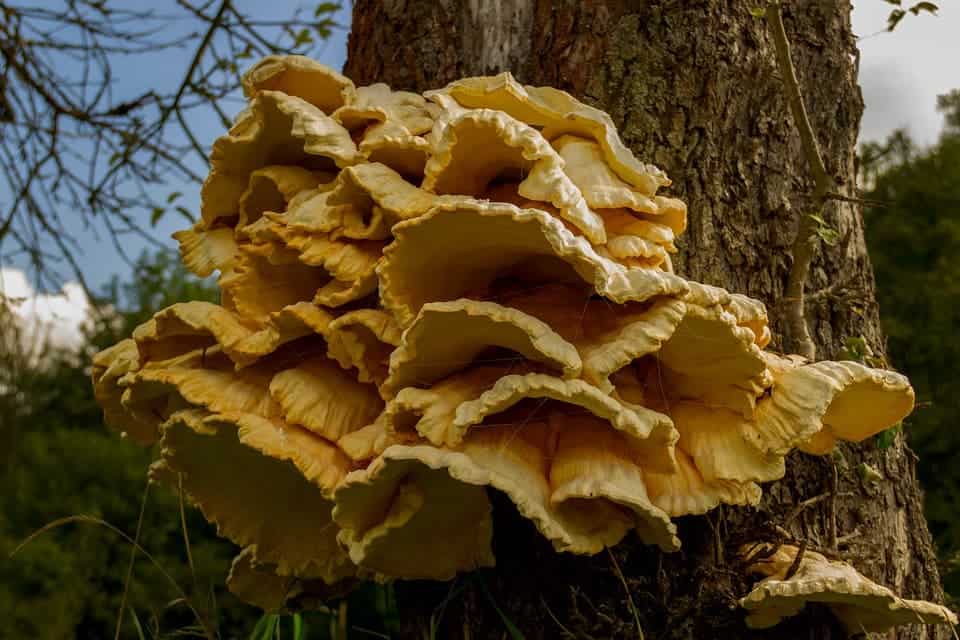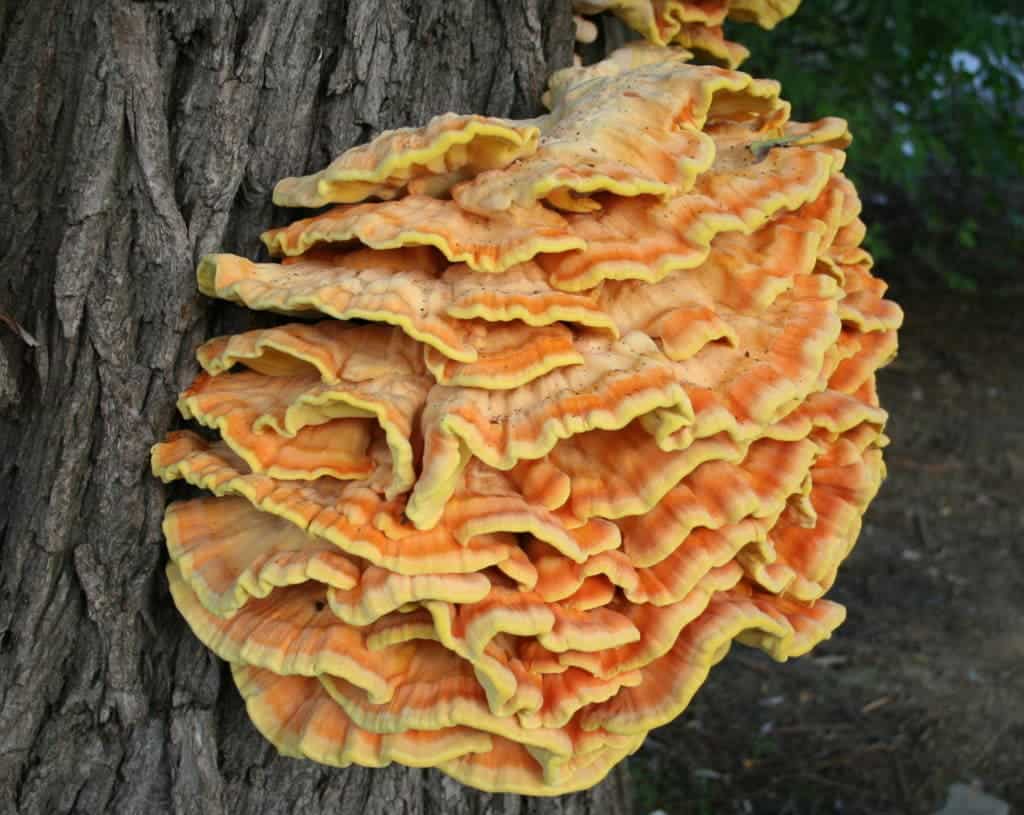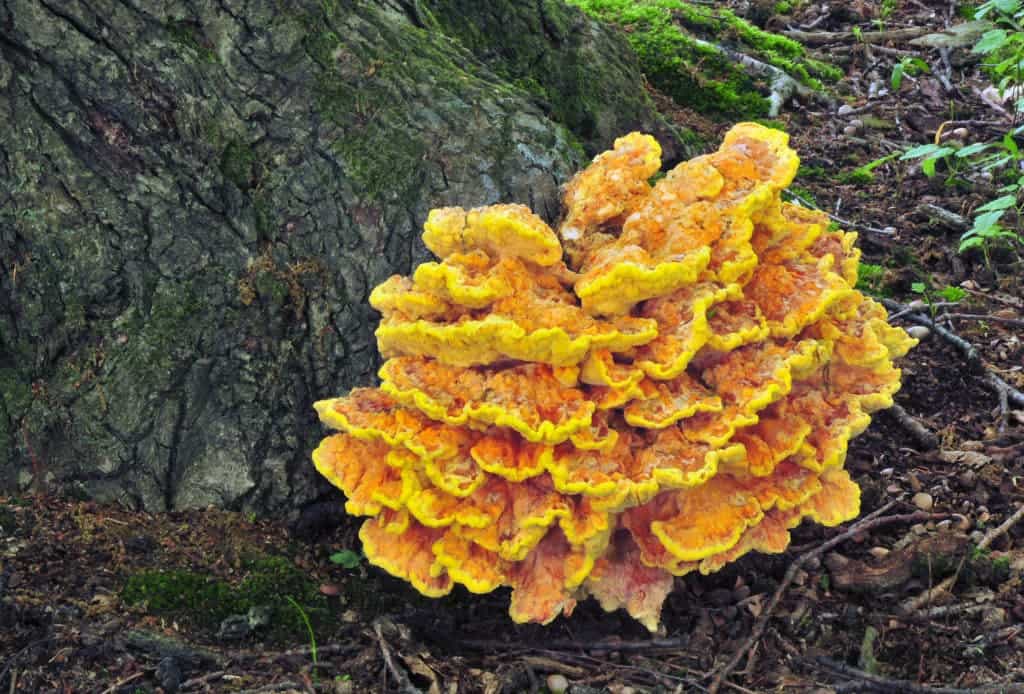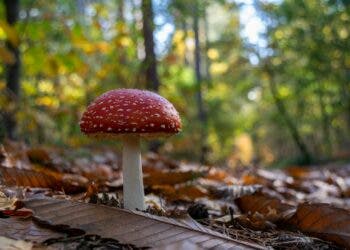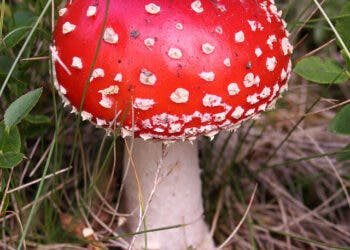People sometimes use the phrase “tastes like chicken” to describe the flavor of an unusual food. It’s in such common usage that the phrase has become somewhat of a cliché. But some weird foods really do taste like chicken. Such is the case of Laetiporus sulphureus — commonly known as the Chicken of the Woods.
What is the Chicken of the Woods?
The Chicken of the Woods is a bracket fungus, which means it grows on the sides of trees and forms shelf-like structures. Unlike many other edible mushrooms, it is easily recognizable, with its bright orange and yellow colors. Mushroom hunters were initially drawn to this fungus due to its distinctive appearance, but it was soon discovered that it had an unusual flavor that could be used as a meat substitute.
Laetiporus sulphureus was first described as Boletus sulphureus by French mycologist Pierre Bulliard in 1789. It’s been known by many designations across the years and was finally given its current scientific name in 1920 by American mycologist William Murrill. Laetiporus means “with bright pores” and sulphureus refers to the pale yellow color of sulfur.
Also called the chicken mushroom, or the chicken fungus, Laetiporus is an easily recognizable, brightly colored fungus that is often found in clusters. The fungus grows in large brackets on trees, mostly oak, that are either living or decaying, causing a reddish-brown heart-rot of wood. If the mushrooms are seen fruiting, you can be sure that the fungus has already attacked the tree.
They’re pretty huge, growing 2 to 20 inches across. Some of the mushroom brackets can weigh up to 100 pounds (45 kg).
The chicken of the woods can also be found growing frequently on eucalyptus, yew, cherry wood, sweet chestnut, and willow.
The top surface of the chicken of the woods is bright orange and tends to lighten in color near the edges. This fungus has no gills, but its bright yellow undersurface is covered with tiny pores. With age, the color of the mushroom dulls from bright yellows to orange and then pure white. Older specimens tend to become brittle, as well.
What does the Chicken of the Woods taste like?
People who’ve tried cooking the chicken of the woods describe it as “succulent”, with a mild flavor. At first bite, you might find the taste oddly familiar, perhaps reminding you of chicken, crab, or lobster. The mushroom is also high in protein (about 14 grams per 100 grams, which is similar to quinoa) and you can feel it.
Even its sinewy texture is oh-so-similar to soft, juicy, tender chicken meat. It can make a fine chicken substitute as long as you make sure to fully cook the mushroom, making it a great ingredient for any vegetarian diet.
But although it’s considered a delicacy, in some parts of the world, like Germany and some regions of the USA, Laetiporus is seen as a pest, since it causes brown rot — a type of tree decay. Historically, this fungus was known to damage the wooden ships of the British Naval Fleet.
Is the Chicken of the Woods safe?
The Chicken of the Woods is edible and quite delicious. However, you should never this mushroom raw as it can cause digestive issues. It is best to cook the mushroom thoroughly before eating. Any stomach pain after eating Chicken of the Woods could be due to an allergic reaction, or it may be a result of consuming a contaminated or undercooked mushroom.
Chicken of the Woods is actually good for those who are looking to maintain a healthy diet, as it is low in fat and high in protein. It also contains fiber and various vitamins and minerals. The fungus is also a good source of fiber and contains a variety of vitamins and minerals, including vitamin D, potassium, and calcium.
However, it is generally a good rule of thumb to be always careful what you eat from foraging in the woods — especially since there is more than just one species of Laetiporus in North America. For instance, Laetiporus huroniensis, which is almost identical to Laetiporus sulphureus, has been associated with some cases of food poisoning, and may also sometimes interbreed with the latter, making it even more difficult to distinguish the two species.
L. huroniensis only grows in northeastern North America and seems to love conifers. In western North America, Laetiporus sulphureus doesn’t naturally occur at all, however, two lookalikes do — Laetiporus gilbertsonii (on eucalyptus) and Laetiporus conifericola (on conifers). Both are known to be implicated in poisonings.
You can contact your local mycological society to find out if there are mushroom foragers in your area. Alternatively, you might be able to purchase some Chicken of the Woods from a local farmers market or specialty store.
Some quick recipes for cooking Chicken of the Woods
The culinary uses for the Chicken of the Woods are endless, and it can be used in a variety of dishes. It is particularly popular in Italian and Mediterranean cuisine, where it is often used in pasta dishes, pizzas, and soups. It can also be used as a filling in tacos, burritos, and enchiladas. Some chefs have even begun using it as a substitute for chicken in traditional chicken dishes, such as chicken alfredo and chicken parmesan.
Here are three simple and delicious recipes using Chicken of the Woods:
- Chicken of the Woods Stir-Fry: Clean and slice the chicken of the woods into bite-sized pieces. Heat oil in a wok or large pan, and add garlic, ginger, and sliced onions. Stir-fry for a minute, then add the chicken of the woods and continue stirring until the mushroom is lightly browned. Serve over rice or noodles with soy sauce, oyster sauce, or another desired sauce.
- Chicken of the Woods Risotto: Clean and chop the chicken of the woods into small pieces. In a large pan, heat oil and sauté garlic, onion, and shallots until soft. Add Arborio rice and cook for a minute before adding white wine and chicken broth, a ladleful at a time, stirring constantly until each addition is absorbed. When the rice is al dente, stir in the chicken of the woods, grated Parmesan cheese, and butter. Serve immediately.
- Chicken of the Woods Pizza: Roll out pizza dough to desired thickness and top with tomato sauce, grated mozzarella cheese, and sliced chicken of the woods. Bake in a preheated oven at 425°F for 10-12 minutes or until the crust is golden brown and the cheese is melted. Serve hot with a sprinkle of fresh basil or any other desired toppings.
NOTE: DO NOT eat any mushroom unless you are absolutely certain of its identity.
